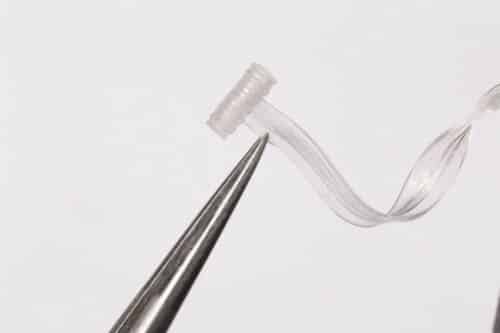
Credit: John Rogers, PhD, et al.
A team of Northwestern University investigators have developed a flexible, tiny, soft implant that can relieve pain without using any drugs. As described in a study published in Science, the first-of-its-kind device could provide a much-needed recourse to opioids and other highly addictive medications.
The implant is a biocompatible, water-soluble device that works by softly wrapping around nerves to deliver precise, targeted cooling, which then numbs the nerves and blocks pain signals to the brain. An external pump facilitates the user to remotely activate the device and then regulate its intensity. After the device is no longer needed, it is absorbed naturally into the body — avoiding the need for a surgical extraction.
John Rogers, PhD, the Louis Simpson and Kimberly Querrey Professor of Materials Science and Engineering, Biomedical Engineering and Neurological Surgery, is the senior author of the study published in Science. Scientists believe that the implant will be most beneficial to patients who undergo surgeries or amputations that commonly require post-operative medication. Surgeons can implant the device during the procedure to help manage the patient’s post-op pain.
“Although opioids are extremely effective, they also are extremely addictive,” said John Rogers, PhD, Louis Simpson and Kimberly Querrey Professor of Materials Science and Engineering, Biomedical Engineering and Neurological Surgery, who pioneered the device’s development. “As engineers, we are motivated by the idea of treating pain without drugs — in ways that can be turned on and off instantly, with user control over the intensity of relief,” says Rogers, also the founding director of the Querrey Simpson Institute for Bioelectronics. “The technology reported here exploits the mechanism that causes your fingers to feel number when cold. Our implant allows that effect to be produced in a programmable way, directly and locally to targeted nerves, even those deep within surrounding soft tissues.”
“As you cool down a nerve, the signals that travel through the nerve become slower and slower — eventually stopping completely,” said study co-author Matthew MacEwan, MD, PhD, of Washington University School of Medicine in St. Louis. “We are specifically targeting peripheral nerves, which connect your brain and your spinal cord to the rest of your body. These are the nerves that communicate sensory stimuli, including pain. By delivering a cooling effect to just one or two targeted nerves, we can effectively modulate pain signals in one specific region of the body.”
To cool the nerves, the device contains tiny microfluidic channels. One channel contains the liquid coolant, which is clinically approved as an ultrasound contrast agent and for pressurized inhalers. Another channel contains dry nitrogen, which is an inert gas. When the liquid and gas flow into a shared chamber, a reaction occurs that causes the liquid to quickly evaporate. Simultaneously, a tiny integrated sensor is used to monitor the temperature to ensure that it’s not getting too cold, which could cause tissue damage.
“Excessive cooling can damage the nerve and the fragile tissues around it,” Rogers said. “The duration and temperature of the cooling must therefore be controlled precisely. By monitoring the temperature at the nerve, the flow rates can be adjusted automatically to set a point that blocks pain in a reversible, safe manner.”
“If you think about soft tissues, fragile nerves and a body that’s in constant motion, any interfacing device must have the ability to flex, bend, twist and stretch easily and naturally,” Rogers said. “Furthermore, you would like the device to simply disappear after it is no longer needed, to avoid delicate and risky procedures for surgical removal.”






